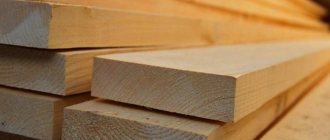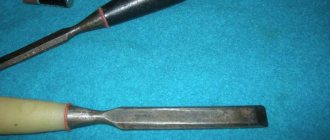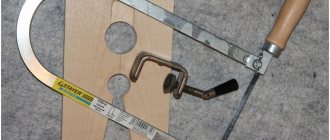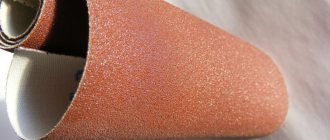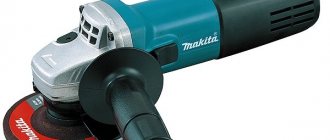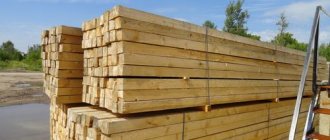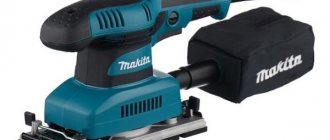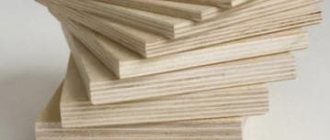What is sandpaper
Emery, sandpaper (or just sandpaper), sandpaper, abrasive or sandpaper - these are all names for the same material. This material is an abrasive on a flexible basis for manual or machine processing of various materials. There is sandpaper for metal, wood, plastic, glass. They are sometimes used for processing plaster and putty, but for these purposes a sanding mesh may be more convenient. It doesn't clog like that.
Sandpaper, sandpaper or paper, sandpaper, sandpaper - that's all about this material
Sandpaper abrasives are small particles of hard materials of varying sizes. These particles are called grains, and their size is called grit. They are glued to a flexible base. Sanding/abrasive paper-based sandpaper is more common. This is the cheapest type, but not the most durable. The fabric base is more reliable, but can stretch, which is also not always convenient when working. Polyethylene-based emery is a waterproof sanding material. This is the most expensive type, but you can even work in water. For wet processing, sanding on waterproof paper is also used.
Sandpaper is used for processing metal, wood, plastic, glass
Sandpaper is used to eliminate irregularities and defects, to obtain a smooth surface, grinding and polishing. So sanding can be rough or fine. By rough we mean the removal of paint or rust, burrs, and the initial leveling of the surface. For this work, material with coarse (from 500 microns to 1 mm or more) and medium (from 200 microns to 500 microns) grains is used. Obtaining an even and smooth surface - grinding, polishing - is already a fine or finishing treatment. For this type of work, sandpaper with fine grain (less than 200 microns) is used.
Fabric based
The fabric base is much stronger than paper.
The fabric is made into skins intended for intensive use in special processing machines. The fabric is elastic, reliable and durable. However, the cost of such sandpapers is slightly higher than paper ones. Appropriate impregnation will make the base even stronger, as well as protect it from the harmful effects of moisture. In addition to fabric and paper bases, there are combined materials. They combine the best properties of each material and are preferred for most jobs. Most coarse-grained skins are created on combined bases.
Sometimes you can find skins on a sponge basis on sale. This approach is very convenient, as it allows you to use the paper intensively for a long time, even in conditions of high dust or humidity.
Hardness and other parameters
Circles are generally classified as soft, medium and hard; These are the main types, to which various epithets are already added. For example, the following are officially known:
- extremely soft;
- very soft;
- medium hard disks.
Additional numbers from 1 to 3 are applied to these brands. To sharpen a tool manually, you need a C1 or C2 abrasive. It is important to understand that the hardness of abrasive wheels can mean different things. In one case, this is the stability of the fastening of abrasive grains in the overall assembly (that is, the resistance of the ligaments to the ejection of grains under mechanical stress). Another is the suitability of the particles used to penetrate other materials.
According to the first option, the hardness of the discs is increased, strengthening the ligament. The total pore volume is reduced, but this does not affect the distances between abrasive particles. A 1.5% increase in bond is considered to add 1 level of hardness. Advanced bonding systems are very tear resistant. They are able to work even at a very high frequency of disk rotation - noticeably higher than the most powerful household drill can provide.
According to GOST 1972, the hardness of abrasive devices is precisely the resistance to tearing out grains under an external impulse. Testing is carried out using 3 key methods:
- according to the depth of the hole, knocked out with a stream of quartz sand;
- by the efficiency of pressing a hardened steel ball under a certain load;
- by drilling a hole to a given depth with a drill of a special design, which is subjected to stable pressure (the key indicator is the required number of turns of the drill to achieve the result).
In some cases, professionals use a TKN device (that is, a cone hardness tester). To operate, its active part is heated to 100 degrees. Then the cone is pressed into a circle. The key parameter is the depth of entry. The hardness of the disc directly affects the grinding process. The soft attachment is suitable for finishing fairly hard materials. However, peeling requires the use of more durable products. Steel that has not been hardened, as well as cast iron, can be processed with a wheel of moderate hardness.
Sandpaper for wood
Wood is considered a softer material, so sandpaper should be selected differently. For processing wooden products, abrasives from:
- grenade;
- ceramics;
- aluminum oxide.
Moreover, each type is used at a certain stage of part manufacturing. Ceramics is used during the formation of the product, as it has high hardness and durability. Garnet and aluminum oxide are used at the stage of painting and leveling the surface.
For wood, choose coarse-grained paper with noticeable gaps between the abrasive particles. The base can be any and depends on the intensity of use.
Manufacturing
The production of such a seemingly simple thing as a strip of paper with abrasive coating is a rather complex technological process and requires appropriate equipment and training of workers. At the first stage, the characteristics of the future sandpaper are printed on the base tape in such a way that they are repeated at a distance equal to the width of the tape.
Next, the tape is impregnated with components to make it waterproof. On the next unit, glue is applied to the surface of the base. Next, pre-sifted and calibrated abrasive chips are applied to the layer of binder material. The next stage is drying in an oven, where the adhesive mass, reacting to the temperature, is baked and firmly attaches the abrasive to the base. Next comes the application of the fixing layer and final drying.
Machine for cutting paper into rectangular sheets
The last operation is cutting the finished tape into rectangular sheets or sheets of other shapes for the manufacture of abrasive belts, gluing them, drying and packaging.
Tips for use
Here are some tips that will help make your work easier and extend the life of the abrasive.
Wood is processed taking into account its fibrous structure. That is, if you need to sand a log or timber, move strictly in the direction of the grain (sanding across the grain can seriously damage the material).
When sanding vertical surfaces, start working from above to avoid dusting the already sanded surfaces. So, when sanding a wall of logs, they first process the topmost log along its fibers, then the second one from the top, and so on. The surface to be sanded must be regularly cleaned of dust (preferably with a vacuum cleaner).
Only dry wood is sanded - no more than 20-22% humidity. When processing wetter wood, there is a high risk that it will warp when drying, in addition, the abrasive will very quickly become clogged with resin and wet shavings
It is advisable to carry out grinding of the log house after the shrinkage has subsided. Before work, it is advisable to de-tar the surface.
It is important to sand the wood smoothly, using even pressure to avoid waves and dents (especially important for machine sanding). It is better to work with an angle grinder at low speeds - this will help not only to better preserve the structure of the wood, but to reduce the wear of the abrasive (when working at high speeds, it heats up more and will fail faster).
The abrasive should be stored in a warm (15-25°C) and fairly dry (relative humidity no more than 35-50%) room.
In cold or high humidity it will quickly become unusable. Grinding is carried out at positive air temperatures.
History[ | ]
| This section is missing references to information sources. Information must be verifiable, otherwise it may be questioned and deleted. You may edit this article to include links to authoritative sources. This mark is set on September 12, 2022 |
The first mention of sandpaper dates back to the 13th century, when in China it was made from ground shells, seeds and sand, applied to parchment using a natural glue.
Some peoples used dried skins of various fish, including shark skin, as sandpaper.
The modern sandpaper was invented by the Englishman John Oakey, the founder of the manufacturer of sandpaper and other sanding materials.
As an apprentice in a musical instrument workshop, he began making his first products by gluing sand and ground glass onto paper. Having improved the technology for mass production, he founded the business in Walworth (London) in 1833, and then moved it to Westminster Bridge Road, where he built a factory on the site of a former orphanage, the building of which was then called Wellington Mills. It has not survived to this day.
Oakey has subsequently developed dry and wet sanding papers and a range of abrasives including shoe polish, dish cleaner, furniture polish, and knife polish (the patented Wellington Knife Polish).
Sandpaper - fine-grained paper-based sheet and coarse-grained fabric-based roll
In Russia
| This section of the article has not been written. According to the plan of one or more Wikipedia contributors, a special section should be located in this place. You can help by writing this section. |
Marking
Sandpaper markings (click to enlarge)
The variety of sandpaper today is classified into two standards. Marking is carried out in accordance with the FEPA standard, as well as the ISO 6344 standard.
The standards of both correspond to Russian GOST, which in turn is recognized by the world community. In some countries, abrasive paper is marked and produced in a special way.
Traditionally, the skin is produced in the form of sheets, called sheets, in rolls, and has the usual markings. Marking “P” is a designation of grain size. The numbers following the letter indicate the limits 12 -2500.
Take note: the higher the grit number, the finer the grains.
The State Standard of the Soviet Union indicated the value of the main indicator in microns. Since then, the classification has been preserved, which is sometimes used in neighboring countries, former republics, and in the storerooms of some zealous owners - M20, M 7, “zero”.
Sandpaper for preliminary work:
- The roughest, primary work on the surface is done using sandpapers containing a large fraction of abrasive:
- P22;
- P24;
- 80-N;
- 63-N;
- 50-N;
- Subsequent treatments are carried out using sandpaper:
- P40;
- P46;
- P60;
- 40-N;
- 32-N;
- Initial sanding requires the use of paper:
- P80;
- P90;
- P100;
- P120;
- 20-N;
- 16-N;
- 10-N;
- The final stage of grinding is carried out using sandpapers:
- P150;
- P180;
- 8-H;
- 6-N.
The gradual use of abrasive material allows you to carefully select all existing flaws, level the surface, and prepare it for finishing, which is also carried out in several stages.
Sandpaper P240
The classification of fine-grained sandpaper involves the use of tools for durable wood (oak, ash):
- primary grinding:
- P240;
- P28;
- 5-H;
- M-6;
- polishing before applying stain, primer, paint:
- P400;
- P600;
- P800;
- M40;
- 2-N.
Sandpaper P1200
Using fine-grained sandpaper for metal and ceramics:
- grinding:
- P1000;
- M20;
- 1-H;
- polishing:
- P1200;
- P1500;
- M7;
- M5;
- P2000;
- P2500 N-0;
- N-01.
The letter “P” means classification according to ISO 6344, the letters “H”, “M” correspond to our domestic marking. Numerical values indicate the size of the abrasive substance fraction.
For example, the P80 value indicates that the marking complies with the international standard, the abrasive is passed through molds measuring 80 per inch. It is not difficult for the buyer to figure out what work needs to be done with one or another tool. The reverse side will help you choose the right sandpaper for its intended purpose.
Compliance tables for other countries
As we see, the situation is not simple. And there is also the American ANCI (USA and Canada), the European FEPA or its other name ISO 6344, the Japanese JIS and the Chinese GB2478. Moreover, on the market you can find material from almost all these countries/parts of the world. So it is advisable to have at least some data. The most common ones are shown in the tables.
Grit designation table for different standards: coarse grain
Sandpaper grit according to different countries' standards: fine-grained
Please note that next to each column the grain sizes in micrometers (µm) are written. Sizes vary. This may be important for work.
Brands of types and sizes
One of the most popular types of grinding wheels are products based on electrocorundum in normal format. It is designated by numbers from 12 to 16 with an additional subsequent letter A. Advantages:
- excellent resistance to high heat
- excellent adhesion to binding components;
- Suitable for machining cast iron and wrought iron, conventional and chromium-improved steel.
If the type is designated as 22A-25A, there is the use of white electrocorundum. It is more homogeneous than the material of the previous group, while being somewhat stronger mechanically. Experts note the presence of sharp edges and the ability to self-sharpen. After processing with such a disk, the surface will be relatively uniform.
32A-34A are grades of chromium electrocorundum. It is suitable for handling weld surfaces made of special steel grades optimized by alloying components. Alternative names are technical ruby or electric ruby. Additionally, the following brands are available:
- 37A – electric corundum with titanium;
- 38A – zirconium circle, characterized by significant mechanical strength;
- 52-55C is black silicon carbide, which is harder than regular carbide, but often loses due to fragility.
The following markings are accepted for diamond blades:
- AC2 is the standard strength for such instruments;
- AC4 – durable products;
- AC6 – even greater strength;
- AC32 – monocrystalline diamonds.
Additionally, the following categories have been introduced into Russian standards and technical regulations:
- AC50;
- EPIRB1;
- ARK4;
- APC3.
The wear resistance of the diamond mass and its strength are achieved simultaneously with a decrease in fragility. Such structures are suitable for handling fragile as well as hard materials. Such equipment, however, can also be used for various operations with optical glass and for sharpening especially hard instruments.
Documentation
Grinding and polishing materials on a paper-like carrier or wicker base are produced in light of the requirements of regulatory documents:
- GOST 6456-82 Sanding paper.
- GOST 13344-79 Waterproof fabric sanding paper.
- GOST 5009-82 Sanding paper and fabric sandpaper and other documents.
The rules for production, grain size, and application are described. The explanation of the marking (designation) of sandpaper is given.
Designation, name
To properly use abrasive material, you need to know about its properties and purpose. For this purpose, an inscription containing information about the abrasive is imprinted on the reverse side with indelible paintwork.
Designation according to GOST: L2E700×110S1G15A25-NMA GOST4, where
Construction type of abrasive material:
L – in sheets; for roll, there is no abbreviation.
Type of media: number 1 – processing of workpieces with low hardness; number 2 – metal polishing. Polyrite fastening: E – electrostatic method. Overall dimensions of the product: sheet, – width × length in mm; roll, – width × length in m. Media: paper 0–200; L1, L2, M – moisture-resistant paper; P1–P11 – non-moisture resistant paper; S1, S1G, S2G, U1, U2, U1G – twill type fabric; P – half-thread fabric. Abrasive grade: 15A – normal electrocorundum; 24A, 25A – white electrocorundum; 43A, 45A – monocorundum; 53С, 54С, 55С – black silicon carbide; 62С, 63С – green silicon carbide; 71St – glass; 81Kr – flint. Grinding grain fraction: 25 – grain size in microns; M63–M3, – micro-grinding, size in microns. Amount of mass composition of abrasive grain: B ≥ 60%; P ≥ 55%; H ≥ 45%; D ≥ 41%. Type of binder: M – hide glue; C – synthetic binder; K – compound binder (M + C); SFK – adhesive composition based on phenol-formaldehyde resin; YAN-15 - amber resin varnish. Abrasion (defects): A ≤ 0.5%; B ≤ 2%; B ≤ 3%. Regulatory document: GOST 6456-82, nominal, non-waterproof type of base; GOST 13344-79, waterproof fabric. Factory marking: 514 – batch designation; May not be entered.
It often happens that a seemingly insignificant thing turns out to be truly irreplaceable, and its scope of application is quite wide. Sandpaper is just one of these necessary things. It is also called sandpaper or sandpaper. It is the most popular abrasive, for which there is no alternative today. Every furniture maker, mechanic, sculptor, as well as car painter and any good owner needs it.
Explanation
Type of binder: M—hide glue; C - synthetic resin; K - combined ligament.
In the old GOST, the sixth letter indicated the class of the abrasive - the number of defects. And no more than 0.5%; B - no more than 2%; B - no more than 3%.
Therefore, the number of defects (A) on the working surface of our example is no more than 0.5%.
or (new European standard using German VSM sandpaper as an example)
Electrocorundum abrasive (K) on a fabric (K) and hard (X) basis with a grain size of P150 (75-106 microns).
When grinding, pre-polishing and finishing cutting edges, grinding wheels, flat bars or flexible sheet materials coated with abrasive chips are usually used as a tool. The latter have two widespread names: popular - sandpaper (sandpaper), and the official GOST - sanding paper.
The common name has been preserved since the times when natural corundite powder (emery) was used as an abrasive, and thick paper was used as a base. Nowadays, industrially produced abrasives are used instead of natural minerals.
Among them, the most common are granular powders based on aluminum oxide, silicon carbide and boron nitride. The base of modern sandpaper can be not only paper, but also fabric, polyester, fiber or a combination, and waterproof and electrostatic adhesives are now used as binders.
Initially, sandpaper was used only for hand sanding. But in the second half of the twentieth century, in connection with the creation of high-strength bases, it began to be widely used in machine grinding: first on belt and drum machines, and then on vibration and orbital sanders.
Peculiarities
The principle of operation of the emery is to remove the top layer of the workpiece. Abrasive chips work like thousands of small cutters, allowing you to shape the material into the desired shape, sand it, remove burrs and defects, or polish the surface. The peculiarity of working with wood is that, on the one hand, effort is required for grinding, but at the same time, almost any impact leaves a mark, and it can be difficult to achieve a smooth surface. Moreover, painting or varnishing does not hide defects, but emphasizes them. Additionally, processing is complicated by the fact that different areas of the tree have different densities and require different pressure.
Therefore, the technology of step-by-step sanding with several types of sandpaper is used for wood - from coarser to softer. Coarse sandpaper at the initial stage allows you to minimize sanding efforts and quickly remove the top layer. And each subsequent one removes too strong scratches and unevenness after the previous one, allowing you to achieve smoothness and shine.
Sanding will not only give a finished and aesthetic appearance to any wooden surface, but will also allow for better protection of the material - protective compounds, water- and fire-retardant impregnations are better applied to the sanded surface.
Therefore, grinding is a necessary stage of all work:
- during restoration, the old layer of paint and the top (damaged) layer of material are removed;
- when leveling the floor, walls and other surfaces, unevenness is eliminated;
- to prepare the material for painting and treatment with protective compounds, the structure of the tree, its “pores” are opened;
- intermediate processing during priming and painting is necessary to smooth out unevenness of the applied layer, lumps of paint, and eliminate adhered particles;
- polishing the final coatings (paint, varnish) allows you to eliminate the smallest defects, micro-scratches, achieving ideal smoothness, shine and protection of the wood.
Sandpaper allows you to work on wood either manually or using special sanders (belt, eccentric, angular) or polishing machines. For manual processing, paper is available in sheet, strip and roll formats. For machines, abrasives are made in the form of belts, disks or flap wheels.
If for manual processing you can choose a sheet of any convenient size, then the consumables for the equipment should match the size of the sole or be slightly narrower. For a tape machine, not only the width is important, but also the length. For example, running sizes are 100x610, 30x533. If the sheets have holes for dust removal, they should match those on the base of the machine.
These are 7 or 6 alphanumeric symbols.
- Type of base. It is designated in the 2nd alphanumeric group. Most often this is paper (denoted by the letter K), fabric (P), polyester (X) or a combined base (C).
- Base density - letter designation in the 5th position (A - thin paper up to 85 g/m2, E - especially flexible fabric, X - rigid fabric, etc.).
- For waterproof skins, the letter W is indicated in the 6th position; for non-waterproof skins, nothing is indicated.
- The method of connecting the abrasive to the base is indicated in the 3rd position. For low mechanical loads, an abrasive secured with a single layer of glue (2) is suitable. A more reliable and wear-resistant skin has two layers of waterproof polymer resin (1) or a double layer of “glue + resin” (3).
- Type of material application - in group 5. For wood, open application (designated 1), stearin application (3), open application stearin coating (4) are best suited - they are less clogged with chips.
The most important characteristics are the type of coating (indicated in the 1st group) and the degree of grain (the last group). Let's look at them in more detail.
Release form
The finished product is available in several forms. Available in the form of sheets or rolls. The leaf shape is characteristic of large fractions that are difficult to bend or roll. Fine-grain paper is available in roll form.
In addition to these forms, there are also:
- abrasive mesh;
- abrasive wheels;
- sanding belts.
The form can be intended for installation in a specific mechanism for processing parts and have a specific appearance.
Types of sandpaper
So, modern sandpaper for wood differs in the following characteristics:
- abrasive;
- Purpose;
- Method of applying abrasive;
- Grain;
- Place of manufacture, since some of its performance qualities depend on this;
- Water resistance.
Below we will take a closer look at all its types.
Pomegranate sandpaper
Types of abrasive
Natural emery is the result of mixing magnetite with corundum. However, in modern conditions these materials are practically not used. The most common types of abrasives are:
| Type abrasive | Peculiarities |
| Electrocorundum | The toughest type of skin, which has excellent cutting ability and resistance to pressure. This abrasive is produced by reduction smelting in a charge. |
| Silicon carbide | It is very sharp, but at the same time fragile grains that crumble under pressure. This abrasive is obtained from an alloy of graphite and silica. This type of skin is often used for processing metal and plastic. |
| Pomegranate | A rather fragile abrasive, but at the same time allowing to obtain a perfectly smooth surface. Therefore, it is often used for wood processing. |
| Diamond | It is the hardest and most durable type of abrasive, but at the same time its price is very high. Therefore, this sandpaper is not used for processing wood. |
Silicon carbide skin
Application technology
Some performance properties of the skin depend on the method of applying the abrasive.
Currently, the following methods are most often used in production:
- Mechanical application - under the influence of gravitational forces, particles are applied in a chaotic order to the canvas.
- Electrostatic method - negatively charged particles in an electrostatic field are attracted to the adhesive base. The peculiarity of this method is that the sanding layer is very sharp.
- With the help of binders - a material that is more durable than an abrasive serves as a binder between the blade and the sanding layer.
- Using adhesives and resins - often the latter have anti-dirt and antistatic additives that increase the durability of the skin.
In the photo - coarse sandpaper
Grain
Based on the density of grains per square inch, or, more simply, the grit size, sandpaper is divided into the following types:
| Grain | Application area |
| 40-60 | Large grains located far from each other. This type of sandpaper is used when performing rough work. |
| 80-120 | Used to remove minor irregularities. Therefore, such sandpaper is also called smoothing sandpaper. |
| 150-180 | Used for finishing. |
| 220-240 | Used for grouting before painting. |
| 280-320 | Great for removing marks before painting. |
| 360-600 | Used for grinding. |
Thus, when choosing which sandpaper to sand wood, you should focus on the type of processing. However, in any case, fine sandpaper is not used for processing wood, as it quickly becomes clogged.
Marking
The marking depends on the country in which the sandpaper is made, since each country has its own system-forming basis.
The following foreign groups are distinguished:
- Japan;
- USA;
- Canada;
- China.
In addition, there is a generally accepted FEPA standard, which corresponds to the Russian standard. This system is based on the designation of the number of grains, which can be from 12 to 5000. The more grains, the less grainy the skin is.
For example, sandpaper P22/24/36 is intended for roughing, as it contains large grains, and wood sandpaper grade P240/280 is used for sanding wooden surfaces. Sandpaper grade P2000/2500 is used for polishing paint and varnish coatings.
Waterproof skin
Water resistance
Another important parameter of the skin is water resistance. It should be noted that moisture-resistant sandpaper is often used for woodworking in industrial settings, in particular for making furniture.
This consumable also has increased elasticity due to the use of a fabric base and special resins. Experts recommend soaking it in water for some time before using it. However, it should be borne in mind that the instructions for using sandpaper largely depend on the type of operation being performed.
Waterproof sandpaper is sold in grain sizes ranging from P80 to P2000. Those. it can be used at all stages of surface treatment.
Here, perhaps, are all the main types of sandpaper, after familiarizing yourself with which you can choose the most suitable sandpaper for performing certain types of woodwork.
What kind of sandpaper to use on metal?
To process metal, you will have to use harder, and therefore more expensive, abrasive materials. Regular corundum will cope with aluminum and its alloys. They also process cast iron, bronze and black steel. For brass you need at least zirconium, but preferably titanium or alloyed electrocorundum. And even better - ceramic. Please also note that the application method must be closed.
For grinding and polishing metal, you need a different type of sandpaper, and we select the grain size according to the type of work
The principle of selecting the grain size is the same: for rough processing, increased “roughness” of the coarse grain; the finer the processing, the finer the abrasive. To remove rust and level out the main roughness, use the coarsest sandpaper. The thinner the layer, the smaller the grain size.
So everything is logical here. But note that for each type of work there are two or three grit sizes. This does not mean that you need to take any of the above. This means that to get a good result you need to process each size. Although, if appearance is not so important to you, then you can use one of the recommended sizes.
Designation of abrasive and grit
It is most convenient to present and analyze the grain parameters of disks in the format of a special table. But here it must be said that these parameters may differ in different gradations, and sometimes it is impossible to find a correspondence. Thus, the categories of processing abrasives F4-F7 on the FEPA scale have no analogues. Grains 3/2 according to standard number 9206 dated 1980 and less do not have matches in standard 3467-80. Here is the table itself:
| Sign according to GOST 3647-80 | According to GOST 9206 from 1980 | Dimensions in microns | FEPA abrasives, except those with a flexible backing (the letter F is omitted from the designation) | Average value in microns |
| 200 | 2500/2000 | 2500-2000 | 8, 10 | 2460, 2085 |
| 160 | 2000/1600 | 2000-1600 | 12 | 1765 |
| 125 | 1600/1250 | 1600-1250 | 14 | 1470 |
| 100 | 1250/1000 | 1250-1000 | 16, 20 | 1230, 1040 |
| 80 | 1000/800 | 1000-800 | 22 | 885 |
| 63 | 800/630 | 800-630 | 24 | 745 |
| 50 | 630/500 | 630-500 | 30,36 | 625, 525 |
| 40 | 500/400 | 500-400 | 40 | 438 |
| 32 | 400/315 | 400-315 | 46 | 370 |
| 25 | 315/250 | 315-250 | 54, 60 | 310, 260 |
| 20 | 250/200 | 250-200 | 70 | 218 |
| 16 | 200/160 | 200-160 | 80 | 185 |
| 12 | 160/125 | 160-125 | 90, 100 | 154, 129 |
| 10 | 125/100 | 125-100 | 120 | 109 |
| 8 | 100/80 | 100-80 | 150 | 82 |
| 6 | 80/63 | 80-63 | 180 | 69 |
But simply determining the grain size of sanding and other discs is not enough. It is also necessary to look at what this classification means in purely practical terms. In descending order of size there are:
- grinding;
- grinding powder;
- micropowders;
- the finest possible micropowder.
Micropowders are designated by the symbol “M”. The index is not difficult to decipher. The number after the “M” shows what the largest particles are in this type of product. It is worth noting that, in addition to the main fraction, at each grain size number even larger, marginal, fine and complex fractions are clearly distinguished.
Large grains are designed for rough finishing of various types of coatings. The smaller cross-section allows for a final abrasive pass. It can also be used for finishing and sharpening. Coarse-grained discs are used to:
- peel and remove allowances with a significant cutting depth;
- work effectively on powerful machines;
- grind materials that close the pores of tools and provoke “salting”;
- work over large areas;
- grind the end flat;
- process products internally.
Wheels with small and medium grain are needed if:
- a coating roughness of no less than 0.08 and no more than 0.32 microns is relevant;
- you will have to work with hardened steel and other hard metals;
- grind and bring devices (devices) to final readiness;
- accurately and efficiently work on a variety of details.
Sandpaper grit
This parameter of abrasive paper displays the number and size of particles of abrasive substance per unit area, is the main characteristic of the sandpaper and determines the possibility of its use for certain needs.
What's the difficulty?
Today in stores you can find sanding paper marked both according to Russian GOST and the standards of other countries.
The confusion is that domestic markings on the skin can be made according to the new GOST of 2005 (focused on European standards) and according to the GOST of the 80s, approved by the Ministry of Machine Tool and Tool Industry of the USSR.
In addition, there is no unity among global manufacturers. The USA and Canada, Europe and Türkiye, Japan, China adhere to their own standard.
Table of grain size, purpose and marking
| GOST R 52381-2005 (Russia) | GOST 3647-80 (USSR) | Grain size (µm) | Purpose |
| Coarse-grained | |||
| P22 | 80-H | 800-1000 | Roughing |
| P24 | 63-H | 630-800 | |
| P36 | 50-H | 500-630 | |
| P40 | 40-H | 400-500 | Rough woodwork |
| P46 | 32-H | 315-400 | |
| P60 | 25-H | 250-315 | |
| P80 | 20-H | 200-250 | Primary grinding Surface smoothing Removing small irregularities |
| P90 | 16-H | 160-200 | |
| P100 | 12-H | 125-160 | |
| P120 | 10-H | 100-125 | |
| P150 | 8-H | 80-100 | Preparing hard wood for sanding Final sanding of soft wood Sanding old paint for painting |
| P180 | 6-H | 63-80 | |
| Fine-grained | |||
| P240 | 5-H,M63 | 50-63 | Final sanding of hardwood Sanding between coats |
| P280 | 4-N,M50 | 40-50 | |
| P400 | M40/N-3 | 28-40 | Polishing final coats Sanding before painting Wet sanding |
| P600 | M28/H-2 | 20-28 | |
| P1000 | M20/H-1 | 14-20 | Grinding of metal, plastics, ceramics Wet sanding |
| P1200 | M14 | 10-14 | Even finer grinding, polishing Removing gloss, stains, micro-scratches |
| P1500 | M10/N-0 | 7-10 | |
| P2000 | M7/N-01 | 5-7 | |
| P2500 | M5/N-00 | 3-5 |
Russian marking. GOST old and new (ISO)
The letter “P” is always indicated first. The number after indicates the grain size.
Old GOST
The first number is the number indicating the size of the abrasive. Next come the indices: P means that the amount of the main fraction of abrasive grain is at least 55%, index H is at least 45%, index D is at least 41%.
To designate micro-grinding powders in the old GOST, the first letter is M. The number behind it is the grain size in microns.
This is what the back side of the sandpaper I purchased just yesterday looks like:
(Below I posted a photo with the new markings)
Areas of application of abrasive skins in accordance with the type of grain size.
Sandpaper with coarse grain (coarse-grained - macrogrid)
- The roughest jobs. Removing burrs and rust. (grain 1000 microns - 500 microns)
New GOST: P22, P24,P30, P36 (hereinafter the sequence is given in order of decreasing grain, i.e. P22 is the largest grain (1000 microns), P36 is the smallest (500 microns))
Old GOST: 80-P, 63-P, 50-P (hereinafter in order of decreasing grain, i.e. 80 is the largest grain (1000 microns), 50 is the smallest (500 microns))
- Rough woodworking. Pre-grinding of various surfaces (500 - 250 microns)
New GOST: P40, P46, P54, P60
Old GOST: 40-P, 32-P, 25-P
- Removing a layer of varnish, paint or drying oil. Elimination of uneven plaster. Intermediate grinding (250 - 100 microns)
New GOST: P70, P80, P90, P100
Old GOST: 20-P, 16-P, 12-P, 10-P
- Final sanding. (50 - 105 µm)
New GOST: P120, P150, P180, P220
Old GOST: 20-P, 16-P, 12-P, 10-P
